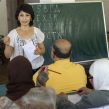
Situation of Circassian Refugees from Syria Reportedly Precarious in Karachaevo-Cherkessia
Publication: Eurasia Daily Monitor Volume: 11 Issue: 176
By:

As civil war rages in Syria, Circassians there are trying to escape to other countries, but few of them have been able to return to their historical homeland in the North Caucasus. A handful of the Circassians ended up in Karachaevo-Cherkessia, where Circassians are the titular ethnic group, but comprise only about 12 percent of the republic’s total population. Accordingly, Circassian refugees from Syria currently residing in Karachaevo-Cherkessia are reportedly in the most precarious situation of all.
After Circassian refugees receive an invitation and enter the Russian Federation, they apply for a temporary residence permit. The Russian government has simplified this procedure for ethnic-Russian refugees from Ukraine, but not for the refugees from Syria. Circassian activist Muhamed Cherkesov scornfully noted how the Russian government awards legal status to refugees depending on their ethnic background. “This [legal permit to live in Russia] pertains to the Ukrainian refugees. Syrian Circassians do not receive such a status, because they are considered to be guests, so no benefits for them.” Russian law essentially puts the responsibility for resolving the problems of the refugees from Syria on the refugees themselves. For example, in order to apply for a temporary residence permit, each member of a refugee family has to have the equivalent of 12 living wages—about $3,000 per person. The permit is granted for three years, but it has to be confirmed every year and each person in the family is required to have the equivalent of $3,000 each time. Naturally, this requirement poses quite a serious challenge to destitute refugees. In addition, the regional government in Karachaevo-Cherkessia reportedly does not provide medical assistance to the refugees, who, therefore, have to cover their own medical expenses. Circassian activists distributed refugees from Syria in private homes in the villages of Khabez, Ali-Berdukovsky and Ersakon as well as in the capital of the republic, Cherkessk (politika09.com, September 24).
Karachaevo-Cherkessia is a small, but ethnically highly diverse republic. Ethnic Karachays, a Turkic-speaking people, make up 41 percent of the population; ethnic Russians come in second, with about 32 percent of the total population; while Circassians (Cherkess) are in third place, with 12 percent. The Abaza—an ethnic group that is linguistically situated between Circassians and the Abkhaz—make up 8 percent. Another Turkic-speaking ethnic group, the Nogais, who are close to ethnic Kazakhs, comprise about 3 percent of the republic’s population. Ethnic Karachays and Circassians are the two most influential ethnic groups in the republic, but ethnic Karachays tend to dominate the republican government. The share of ethnic Russians in Karachaevo-Cherkessia dropped from 42 percent in 1989 to 32 percent in 2010. In the same period, the share of ethnic Karachays rose from 31 percent to 41 percent. The number of Circassians in the republic in the same period rose from 10 to 12 percent.
Meanwhile, the Circassian Repatriation Organization (CRO), a Circassian organization dedicated to the repatriation of Circassians to their homeland, announced the start of collecting data on the Circassian returnees and refugees. CRO cooperates with Circassian non-governmental organizations and republican governments in the North Caucasus and tries to coordinate the efforts of the Circassian activists to help people in need, especially in Syria. According to statistics collected by the organization, the Circassian republics of the North Caucasus have taken in 1,624 refugees from Syria. Over 1,000 have settled in Kabardino-Balkaria, about 600 in Adygea and a mere 24 refugees currently reside in Karachaevo-Cherkessia. For comparison, an estimated 6,000 Circassian refugees are in Turkey and 4,000 in Jordan, while other countries took in another 2,000 Circassian refugees from war-torn Syria. CRO further stated that “based on the number of abandoned Circassian villages and Circassian communities in the cities in Syria today, the number of internal refugees is about 15,000” (circassianrepatriation.com, accessed October 6).
Despite the relatively small number of Circassian refugees from Syria, Moscow has been quite reluctant to allow them in. Luckily for the Circassian refugees, the crisis in Syria coincided with the Winter Olympics in Sochi earlier this year, so the Russian authorities appeared to be more lenient in allowing in some Circassian refugees from the civil war zone in the Middle East, in order to dampen Circassian opposition to the Sochi Olympics. However, as Moscow became more reassured that it could control the situation at the Olympic sites and not fear Circassian protests, visa restrictions and pressure on the Circassian activists grew. The government suppressed small protests in Nalchik, Kabardino-Balkaria, which took place on the opening day of the Olympic Games (Kavkazsky Uzel, February 7).
The Russian government’s strategy toward the Circassian refugees from Syria appears to have evolved into a sophisticated containment strategy. Instead of expressly prohibiting the influx of Circassian refugees from Syria, the Russian government denies them visas. Those refugees who have managed to sneak in receive no assistance from the government. Circassian organizations that were able to provide assistance to a significant number of refugees, such as the Peryt organization, have since been shut down. Small groups of Circassian activists who can help only a handful of refugees from Syria are ignored as Moscow does not seem to mind accepting insignificant number of Circassian returnees.




